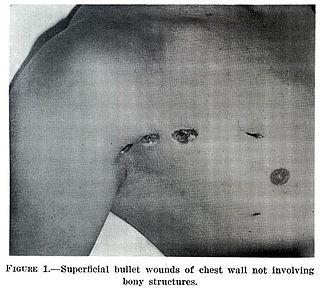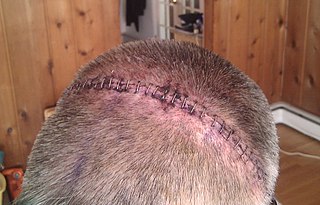Related Research Articles

Cyanoacrylates are a family of strong fast-acting adhesives with industrial, medical, and household uses. They are derived from ethyl cyanoacrylate and related esters. The cyanoacrylate group in the monomer rapidly polymerizes in the presence of water to form long, strong chains. They have some minor toxicity.

A wound is a type of injury which happens relatively quickly in which skin is torn, cut, or punctured, or where blunt force trauma causes a contusion. In pathology, it specifically refers to a sharp injury which damages the epidermis of the skin.

A staple is a type of two-pronged fastener, usually metal, used for joining or binding materials together. Large staples might be used with a hammer or staple gun for masonry, roofing, corrugated boxes and other heavy-duty uses. Smaller staples are used with a stapler to attach pieces of paper together; such staples are a more permanent and durable fastener for paper documents than the paper clip.

A stapler is a mechanical device that joins pages of paper or similar material by driving a thin metal staple through the sheets and folding the ends. Staplers are widely used in government, business, offices, work places, homes and schools.

An adhesive bandage, also called a sticking plaster, medical plaster, or simply plaster in British English, is a small medical dressing used for injuries not serious enough to require a full-size bandage. They are also known by the genericized trademarks of Band-Aid or Elastoplast.

Skin grafting, a type of graft surgery, involves the transplantation of skin. The transplanted tissue is called a skin graft.
Setting the features is a mortuary term for the closing of the eyes and the mouth of a deceased person such that the cadaver is presentable as being in a state of rest and repose, and thus more suitable for viewing. While it is one of the first stages of embalming, it is also commonly done as a token of respect even when the deceased is not viewed or is directly cremated. Generally only when the deceased have specifically requested the body be untouched are the features left unset.

Anal fistula is a chronic abnormal communication between the epithelialised surface of the anal canal and usually the perianal skin. An anal fistula can be described as a narrow tunnel with its internal opening in the anal canal and its external opening in the skin near the anus. Anal fistulae commonly occur in people with a history of anal abscesses. They can form when anal abscesses do not heal properly.
A barbed suture is a type of knotless surgical suture that has barbs on its surface. While suturing tissue, these barbs penetrate inside the tissue and lock them into place, eliminating the need for knots to tie the suture. Conventional sutures rely on a surgeon's ability to tie secure knots; barbed sutures provide a knotless alternative in some surgical situations. Barbed sutures are primarily used in cosmetic surgery.

Surgical staples are specialized staples used in surgery in place of sutures to close skin wounds or connect or remove parts of the bowels or lungs. The use of staples over sutures reduces the local inflammatory response, width of the wound, and time it takes to close.

The vertical mattress stitch, often called vertical Donati stitch, is a suture type used to close skin wounds. The advantages of the vertical mattress suture are that it provides closure for both deep and superficial layers, and also allows perfect eversion and vertical opposition of the superficial skin edges. Its disadvantage is a relatively high propensity to dig into skin and cause prominent stitch mark scars.

In body modification, an implant is a device that is placed under the human skin for decorative purposes. Such implants may be subdermal or transdermal. In the context of body modification, some may consider injections of silicone and other substances a type of implant as well.

Surgical suture is a medical device used to hold body tissues together after an injury or surgery. Application generally involves using a needle with an attached length of thread. A number of different shapes, sizes, and thread materials have been developed over its millennia of history. Surgeons, physicians, dentists, podiatrists, eye doctors, registered nurses and other trained nursing personnel, medics, clinical pharmacists and veterinarians typically engage in suturing. Surgical knots are used to secure the sutures.
Monocryl is a synthetic, absorbable suture manufactured in Cornelia, Georgia, USA, and trademarked by Ethicon. It is composed of poliglecaprone 25, which is a copolymer of glycolide and epsilon-caprolactone. It comes both dyed (violet) and undyed (clear) and is an absorbable monofilament suture.

Wound closure strips are porous surgical tape strips which can be used to close small wounds. They are applied across the laceration in a manner which pulls the skin on either side of the wound together. Wound closure strips may be used instead of sutures (stitches) in some injuries, because they lessen scarring and are easier to care for.

n-Butyl cyanoacrylate, a cyanoacrylate ester, is a butyl ester of 2-cyano-2-propenoic acid. It is a colorless liquid with a sharp, irritating odor. It is insoluble in water. Its chief use is as the main component of medical cyanoacrylate glues. It can be encountered under various trade names, e.g. Cutseal, MediBond, MediCryl, PeriAcryl, GluStitch, Xoin, Gesika, VetGlu, Vetbond, LiquiVet, Indermil, LiquiBand, Histoacryl, IFABond, CutisSeal and others. The generic international nonproprietary name (INN) for NBCA is enbucrilate.

Fibrin glue is a surgical formulation used to create a fibrin clot for hemostasis or wound healing. It contains separately packaged human fibrinogen and human thrombin.
In surgery, a surgical incision is a cut made through the skin and soft tissue to facilitate an operation or procedure. Often, multiple incisions are possible for an operation. In general, a surgical incision is made as small and unobtrusive as possible to facilitate safe and timely operating conditions.
Hydrophobic light-activated adhesive (HLAA) is a type of glue that sets in seconds, but only after exposure to ultraviolet light. One biocompatible, biodegradable HLAA is under consideration for use in human tissue repair as a replacement for sutures, staples and other approaches.

Glued IOL or Glued Intraocular lens is a new Surgical technique for implantation of a posterior chamber IOL with the use of biological glue in eyes with deficient or absent posterior capsules. A quick-acting surgical fibrin sealant derived from human blood plasma, with both hemostatic and adhesive properties is used.